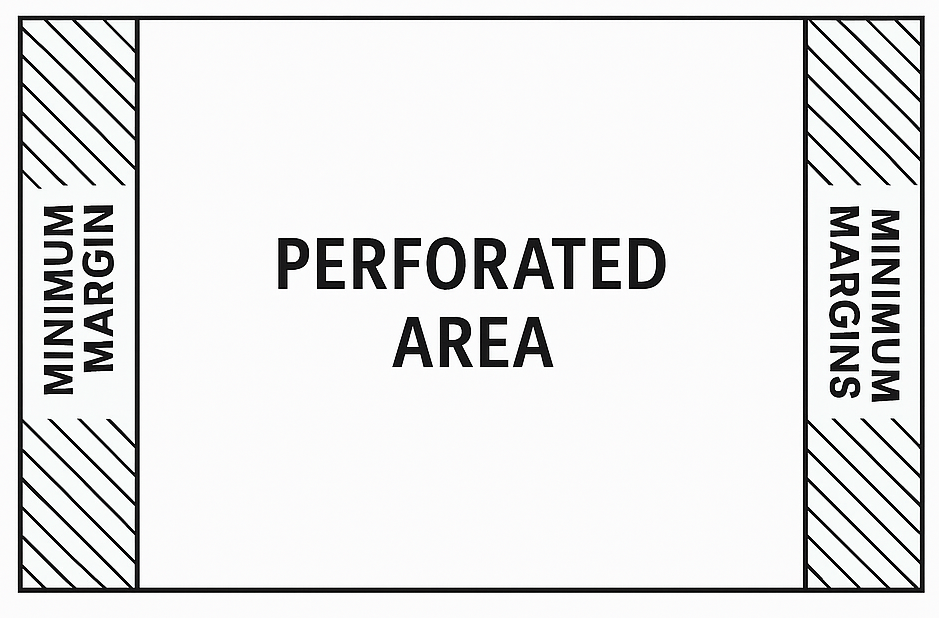top of page
Definitions for Perforated Metal Sheets

This page explains the basic terms used when ordering perforated metal. We keep the definitions clear and straightforward so you can quickly confirm the right pattern, spacing, and material for your project.
If you have questions or a drawing, our team can help.
Thickness of Metals
Metal thickness is described using gauges or exact decimal measurements.
Common Thickness Reference
-
Manufacturers’ Standard Gauge (most common for steel)
-
Stainless Steel Gauge (slightly different scale)
-
Decimal Thickness (exact measurement in inches or millimeters)
Guideline
Smaller gauge number = thicker material.
Thickness

*Not to size, just for demonstration*
Perforations
Perforations refer to the shape of the holes punched into the sheet.
Common Types
-
Round — Most common and cost-effective. Available in staggered or straight patterns.
-
Square — Modern, clean appearance. Available staggered or straight.
-
Slotted — Long, narrow openings. Slots can run the width or length of the sheet.
-
Custom Shapes — Specialty perforations available upon request.
Perforations

Spacing of Perforations
Spacing describes how far apart the holes are placed on the sheet.
How Spacing Is Measured
-
Centers — Distance from the center of one hole to the center of the next.
-
Open Area — The percentage of the sheet that is open (hole area vs solid metal).
-
Holes Per Square Inch — Used for small perforations where center-to-center spacing is less practical.
SPACING OF PERFORATIONS

Pattern of Perforations
The pattern describes how the holes are arranged across
the sheet.
Common Patterns
-
Staggered (60°) — Most common. Provides strong strength-to-open-area balance.
-
45° Staggered — Alternative stagger orientation used for certain design or flow requirements.
-
Straight-Line Pattern — Holes aligned in straight rows and columns; used for specific visual or functional needs.
-
Slotted Pattern Orientation — Slots can run parallel to either the width or the length of the sheet.
PATTERN OF PERFORATIONS

Margins
Margins refer to the solid (non-perforated) areas along the edges of a sheet.
Types of Margins
-
Unfinished / As-Produced Margins
Natural margins produced during perforation. Width varies depending on the tooling and pattern. -
Finished / Resheared Margins
Edges cut to a specific size after perforating. This creates clean, consistent margins around the sheet. -
Special Margins
Custom margin widths, offsets, or patterns available upon request.
MARGINS

Flatness
Flatness refers to how level a perforated sheet remains after punching. Because perforating removes material, some distortion is normal.
Standard Flatness
Most sheets follow general industry flatness guidelines after perforation.
Special Flatness Requests
Tighter flatness requirements may be available depending on:
-
Material type
-
Thickness
-
Pattern
-
Open area
-
Width and length of the sheet
FLATNESS

Hole Size Guidelines
Hole size affects strength, tool life, and manufacturability. These guidelines help ensure a clean, accurate perforation.
General Recommendations
-
Hole Size ≥ Material Thickness
For most patterns, the hole diameter should be at least as large as the material thickness.
(Example: 0.060" material → minimum 0.060" hole) -
Smaller Holes Are Possible
Sub–material-thickness holes may be available depending on the pattern, tooling, and material type. -
Open Area Impacts Strength
Higher open area reduces sheet strength; lower open area increases rigidity.
HOLE SIZE GUIDELINES

Bar Width Guidelines
The bar is the solid metal between holes. Proper bar width helps maintain strength and ensures clean perforation.
Recommended Guidelines
-
Bar Width ≥ Material Thickness
A general rule is to keep the bar at least as wide as the sheet is thick.
(Example: 0.050" material → minimum 0.050" bar) -
Narrower Bars May Be Possible
Depending on the pattern, tooling, and open area, some designs allow reduced bar widths. These require evaluation on a case-by-case basis. -
High Open Area = Weaker Bars
As open area increases, the bar becomes thinner and overall sheet strength decreases.
BAR WIDTH GUIDELINES

bottom of page
